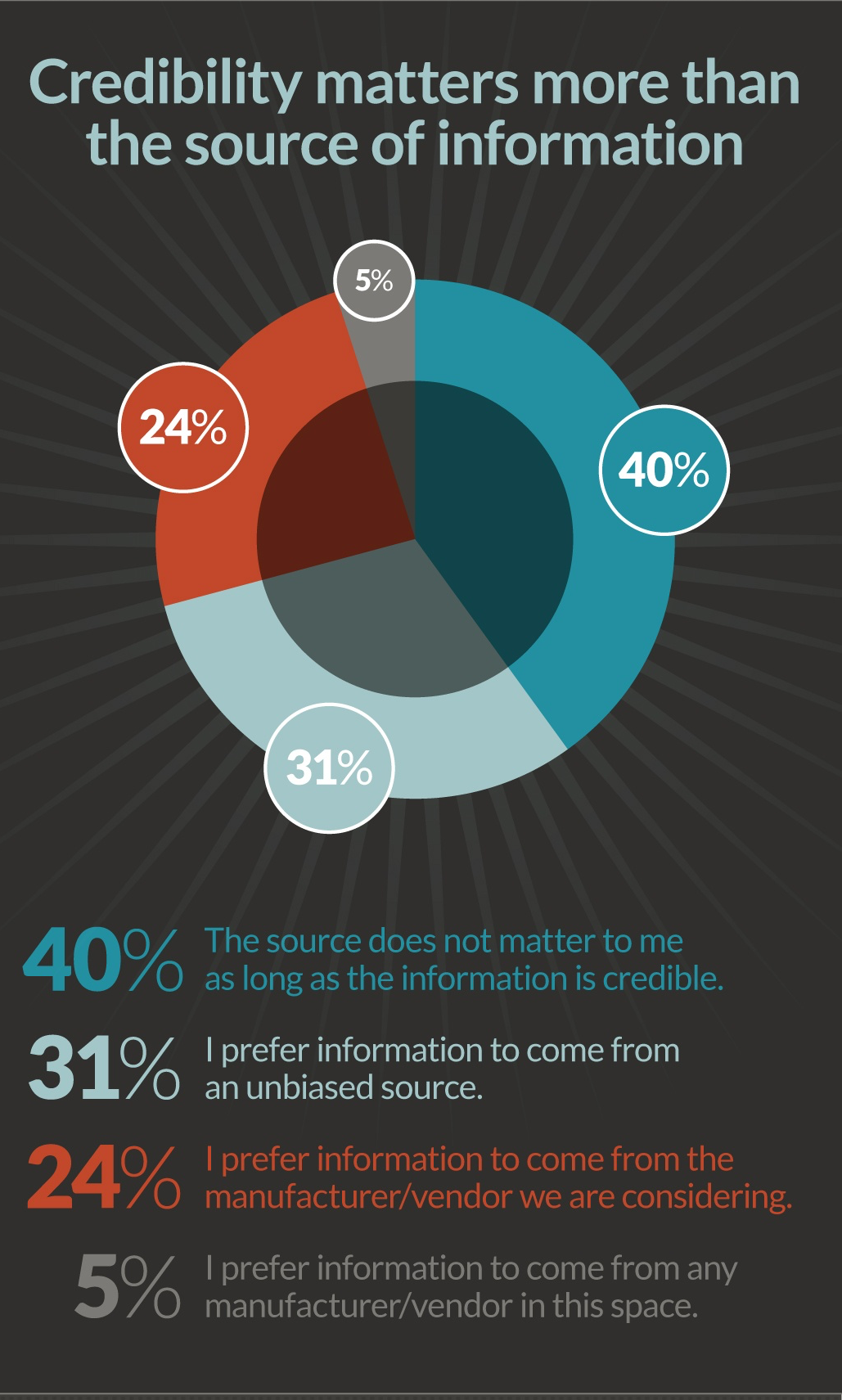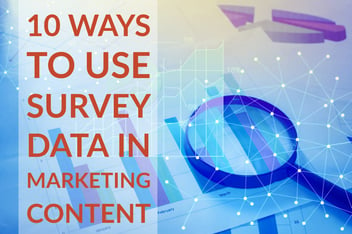How To Build Surveys That Fuel Marketing Strategies

Some of the most compelling market content, especially in the B2B marketplace, is built on original research, data, and statistics that provide decision makers with solid information.
While most marketers are familiar with using surveys for market research to develop customer personas and optimizing marketing tactics, fewer have capitalized on the power of data as a basis for their actual marketing content, from reports and blog posts to videos and thought leadership articles. When used this way, surveys can provide the data that sets your marketing materials apart from the competition.
Surveys are a great source of the kind of credible information B2B buyers want, as we discussed in this blog post: B2B Marketing Content: What Buyers Want From Vendors.
Could your marketing content benefit from a dose of data?
Here are 9 steps to help you create surveys and maximize the use of the results in your marketing strategy.
1. Choose the topic(s) you want to include and the stories you want the data to tell.
What topics are your customers seeking information about? What questions do they have that your survey can answer? What data can you gather that will help them solve problems?
In many ways, these are the same questions your marketing content team should be asking any time you set out to create a new marketing campaign. But now, think of it in terms of how you can provide data-driven advice and insights by doing your own surveys. This step of the process should include those people deeply involved in content creation who will be putting the survey results to use: marketing, PR or general communications team members.
You’ll find more details on choosing topics and starting your survey process with an idea of what stories you want to tell in this blog post: The First Step To Writing Surveys That Generate Data You Can Use.
2. Determine details about the survey execution.
Who will create and conduct the survey — a specialized research firm, a partnering marketing agency, your in-house staff, or some combination?
How will the survey be executed? Platforms options for a digital survey range from a research firm’s proprietary software to commercially available services such as SurveyMonkey.
How will you promote and distribute the survey? Do you have an appropriate contact list for the topics you are covering, or do you need to find a source for a distribution list? Are you using a limited list of respondents, or opening it up to the world and promoting widely through channels such as social media?
What time frame will the survey be open, and how many respondents will you need to generate data that is useful and reliable?
Many of these questions may be best answered with input from experienced researchers or a partner agency. If you need to find a partner to guide these discussions, this blog post provides questions you should ask as you interview potential agencies: How To Choose A Survey Partner.
3. Write the survey questions.
Writing survey questions is a science and an art, and requires understanding what information is being sought and how it will be used, in order to craft questions that provide useful, meaningful results.
This means writing questions that support the key topic(s) and stories chosen in Step 1, using the appropriate format for the data sought. Survey question formats can include rating scales, multiple choice, semantic differential, matrix, pair comparisons and open-ended questions. You will also need to put thought into what questions are needed for gathering basic demographic information and for screening responses, if needed, to ensure they fall within the specific parameters of your research (such as having a specific job title or living in a specific geographic area).
In writing the survey, you should also keep in mind the overall length of the survey, the length of time it takes to respond, and barriers that may prevent respondents from completing the survey. What may be a tolerable length for one survey topic and cohort, may not be for another.
4. Set up the survey in the chosen platform.
If you are working with a partner marketing agency or research firm, this detailed, behind-the-scenes task will likely be their responsibility. Careful attention to detail will be needed, plus reviews and test runs, to ensure that all questions are properly linked, any needed rules are created and used in the algorithms, and that the entire survey has been proofread and tested before being approved for execution and promotion.
5. Launch and execute the survey.
Once everything has been approved, it’s time to go live. Following the plans outlined in Step 2, the survey should be distributed or promoted to the contact lists and target audiences identified. This could be as simple as one or two email “pushes” to specific recipients from your own opt-in contact lists, or a full-on email, social media and paid promotional campaign to reach a wide population for a larger scale consumer survey.
Throughout the process, you should be monitoring to ensure results are coming in as expected. The survey should have a defined stopping point, either after a set time period or once a specified number of responses have been tallied. If not enough responses are received to provide valid data, you will need to decide whether to extend the survey period or abandon the project.
6. Close survey and export data for analysis.
Survey results should be compiled into easily-readable spreadsheets with full results, in addition to teasing out specific stats that are especially relevant for the content planned as a result of the survey. Ensure that if you work with a partner agency that your agreement includes that you will receive the complete data set, not just a page or two of highlights.
Once the results have been tallied, reviewed and analyzed, your team may want to conduct additional research with outside sources to add additional context to the results before entering the next step of the process.
7. Outline a complete content strategy.
While you identified general topics and stories in Step 1, now is the time to lay out a specific plan for creating and using marketing content pieces utilizing your survey data.
One place to begin is by creating a short abstract for each campaign you can create from your data. This abstract provides the basis for outlining individual content pieces that address all stages of the sales funnel in a range of formats.
Examples of the content you may want to create include downloadable reports (gated behind landing pages, if you’d like to use them to capture online leads), business blog posts, videos, social media posts, infographics, and thought leadership articles. (Download Maximizing Market Surveys for a guide to turning a single survey into more than 100 pieces of marketing content.)
To make the most of your content for inbound marketing—attracting and capturing online leads, then using marketing automation to nurture them before turning them over to sales as marketing-qualified leads — plot out how you will use each piece of content in a lead generation or lead nurturing campaign.
8. Create the campaign(s) outlined in Step 7, using your data as a foundation for the content.
Now it’s time to get your best content creation crew started, whether they are in-house writing wizards, freelance designers, or the team of your marketing agency. Use the strategy outlined above to develop the campaign materials that use market and industry data and feedback to generate leads, drive brand awareness and enhance thought leadership opportunities.
Find a few tips on what it takes to create great content in these links:
-
Ask Yourself 3 Questions When Creating Content For Inbound Marketing
-
Two Mistakes That Are Crippling Your Content Creation Efforts
9. Review the process to prepare for next time.
Take time for an analysis of the entire process, from the original brainstorming session that identified topics to cover through the creation of content and its performance in your inbound marketing strategy.
What went well? What didn’t work?
Identify strengths and weaknesses in the process, missed opportunities, and areas for improvement in the implementation of the survey itself or in the use of the resulting data and content. Document what changes you will make for the next survey.
Original research, including surveys, is a great source of content to drive inbound marketing. It provides your company with not only the means to capture leads through inbound marketing, but a stronger position as a thought leader in your industry. It shows that you understand your customers and are committed to continuing to learn more and share that knowledge with them.
Find more guidance on using surveys by downloading our Consumer Survey Development Process Template and Maximizing Market Surveys.

-1.png?width=1652&height=294&name=Jones(RGB)-1.png)








.jpg?width=352&name=Using%20Surveys%20For%20Marketing_%20Roadmap%20To%20Success%20(infographic).jpg)


